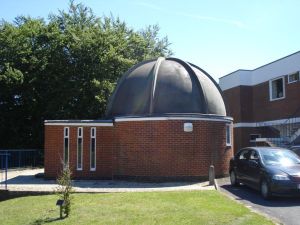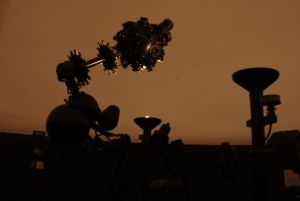 In honour of National Astronomy Week, the Royal Masonic School hosted several astronomy evenings for members of the public and school community during the week of March 3rd. The sessions, run by Head of Physics Kevin Watson and Richard Westwood of the South West Herts Astronomical Society took place in the school’s planetarium which is equipped with a classic Carl Zeiss projector built in the 1940s.
In honour of National Astronomy Week, the Royal Masonic School hosted several astronomy evenings for members of the public and school community during the week of March 3rd. The sessions, run by Head of Physics Kevin Watson and Richard Westwood of the South West Herts Astronomical Society took place in the school’s planetarium which is equipped with a classic Carl Zeiss projector built in the 1940s.
“We watch programmes on TV about space and find out what astronomers with large, sophisticated equipment can see. However, we wanted to show people that there is a lot that can be seen with basic equipment such as a simple
pair of binoculars and encourage them to get out and look at the night sky,” said Richard.
Those attending were treated to explanations of how to find certain constellations and the mythology behind their names. Astronomical phenomena that can be seen without a telescope were identified for those attending, including The Orion Nebula, which is a ‘cloud of gas that will eventually become stars’ and can be found just below the ‘belt’ in
the constellation of Orion.
Other exciting opportunities for the general public include catching a glimpse of the planet Jupiter which is currently at its closest point to earth in its orbit, as well as four of Jupiter’s moons, all named after lovers of Zeus.
 The star of Arcturus, whose name comes from the ancient Greek ‘Arktouros’ which means Bear Guard or The Watcher of the Bear, is one of the brightest stars that can be seen from earth. It can be found by following the arc of the handle of the Big Dipper constellation and it will be very bright in April.
The star of Arcturus, whose name comes from the ancient Greek ‘Arktouros’ which means Bear Guard or The Watcher of the Bear, is one of the brightest stars that can be seen from earth. It can be found by following the arc of the handle of the Big Dipper constellation and it will be very bright in April.
The presentations on the night sky were followed by a brief question and answer session where participants learned about how the projector works and what a supernova is. We even learned that Betelgeuse, a very bright star that
makes up part of the constellation of Orion is due to explode and become a supernova ‘soon’ – of course, ‘soon’ in astronomical terms means a million years so no one left the enchanting evening worried about the future of life on
earth.
Headmistress Diana Rose, who attended the Friday evening session, is delighted that local schools and members of the public can benefit from access to this exceptional facility. She states, “RMS is one of only two schools nationally to have a planetarium and we are pleased that the community has the opportunity to enjoy stargazing with us.” The planetarium has hosted a variety of community based groups. Anyone who is interested in such an opportunity is encouraged to contact Kevin Watson by email: kwatson@royalmasonic.herts.sch.uk.
The South West Herts Astronomical Society was founded in 1968, with the aims of promoting the science of astronomy and encouraging popular interest in the subject. See the SWHAS website for more informationhttp://www.swhas.org.uk.